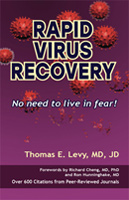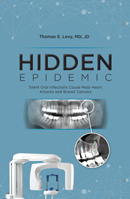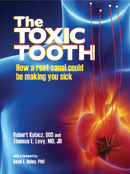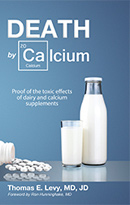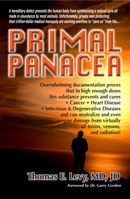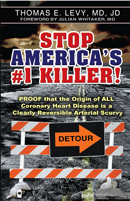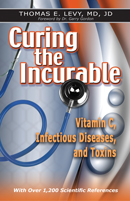Atherosclerosis is a Non-Healing Wound
09/08/2022 by Dr. Thomas LevyCommentary by Thomas E. Levy MD, JD and Ron Hunninghake, MD
OMNS (Sept. 8, 2022) While chronic inflammation of the coronary artery wall is finally appreciated to be the direct cause of all coronary atherosclerosis by cardiologists and internists, there appears to be little curiosity as to what is causing this pandemic of inflammation that remains the leading cause of death worldwide. [1,2] When a 50-year-old man has a heart attack but is completely free of all known risk factors for heart disease, the treating cardiologist just considers that individual to have had bad luck, although that sentiment is never directly expressed to that individual. Truth be known, luck is involved in whether someone becomes a heart patient. However, it pertains directly to the luck involved in whether that individual chose to see a well-informed biological dentist earlier in life rather than just a procedure/tooth structure-oriented mainstream dentist who has no awareness of, or concern with, the dynamic physiological interplay between the mouth and the rest of the body.
Coronary Atherosclerosis Pathophysiology
Over fifteen years ago, the main subspecialty journal for cardiologists, Circulation, reported on the presence of pathological bacterial species found in the atherosclerotic plaque specimens obtained from 38 coronary heart disease patients. The specimens were obtained via catheter-based atherectomy. In ALL 38 patients, polymerase chain reaction (PCR) testing revealed the DNA signatures of such bacteria, with over 50 different species being identified. [3] In 92% of those specimens the DNA of 2 to 9 different species of fungus was detected as well. Control specimens revealed no evidence of either bacteria or fungi. [4] Other studies have also shown a high incidence of pathogens, including viruses, in atherosclerotic plaques in the coronary arteries and elsewhere. [5-10]
Patients presenting with myocardial infarctions secondary to acute coronary occlusions precipitated by soft platelet clots depositing on atherosclerotic plaques were investigated as well. These clots were aspirated at angiography and analyzed by PCR testing. The overwhelming majority of these clots had DNA signatures from periodontal (oral) pathogens. Furthermore, the concentration of this DNA was 16-fold (1,600%) higher in those clots than in the surrounding blood. It would defy logic to consider these pathogens as anything other than the primary reason for that clot developing on the atherosclerotic plaque, although the authors would only go so far as to conclude that the clots "may be associated" with the oral bacteria that accumulated inside them. [11] In the medical literature it is almost impossible to find an article that definitively concludes a cause-and-effect relationship between any factor and any outcome. Rather, the boldest conclusion that is ever reached is that an association, correlation, or relationship of some sort is present, followed by the ever-present advice that more studies are needed.
Chronic Pathogen Colonization Causes All Atherosclerosis
Chronic pathogen colonization (CPC) in an arterial wall both initiates and sustains the evolution of atherosclerosis. Wherever a CPC gets established, pro-oxidant (toxic) molecules are continuously produced secondary to the metabolism of the pathogens. Furthermore, when some of those pathogens do finally die, they also release endotoxins, exotoxins, and an abundance of free iron, all of which are highly pro-oxidant in nature. As a direct result of this CPC insult, the arterial wall is quickly depleted of its antioxidant content, especially vitamin C. Once this occurs, the vessel wall can never again be restored to its normal antioxidant status until the focal infection sites that are continuously sustaining the CPC can be completely resolved or at least stabilized. Supplemental vitamin C will always help, but to a variable degree depending on how many focal infections are present and how "leaky" they are in releasing their pathogens and toxins into the blood. A small number of coronary patients can demonstrate a regression of atherosclerotic lesions by taking large doses of vitamin C while leaving the focal infections unaddressed. However, most coronary patients can only realistically hope for stopping or slowing the atherosclerotic process by taking vitamin C without resolving the seeding sites of infection.
Once the pathogen presence in the arterial wall has metabolized all of the vitamin C present and virtually no measurable amounts of vitamin C remain, a state of inflammation results. Inflammation cannot exist where vitamin C levels are normal or near-normal. Acute focal vitamin C deficiency and acute focal inflammation are actually synonyms for the same physiological state. And once the arterial wall becomes inflamed, an acute immune response ensues. Quite literally, CPC in the arterial wall results in a state of focal scurvy (severe vitamin C deficiency). Inflammation never occurs spontaneously, as it only develops where increased oxidative stress has consumed excess amounts of vitamin C.
The acute immune response that seeks out sites of inflammation in the body has some noteworthy characteristics. The first cells that mobilize and reach the inflamed tissue are monocytes, which are heavily laden with vitamin C, more so than any other cells. The concentration of vitamin C in monocytes has been shown to be more than 80-fold (8,000%) higher than the surrounding plasma. Regular white blood cells, while still having relatively large concentrations of vitamin C, have only about one third of the concentration seen in monocytes. And unlike the white blood cells, the monocytes also have the ability to maintain their high vitamin C content in the face of lowered plasma concentrations. [12-14] In cell cultures, human monocytes were able to maintain a concentration gradient of 100-fold across the plasma membrane. [15]
The cells leading the acute immune response indicate that the prompt delivery of highly-concentrated vitamin C is a crucial part of the mechanism by which the immune response alleviates the inflammation that has developed. And as incredibly complex as the immune system is known to be, it is always inflammation that triggers the immune response, and an associated vitamin C deficiency is always present. Just as vitamin C deficiency results in inflammation, vitamin C repletion resolves it when enough can be delivered. In spite of its numerous metabolic pathways and components, the ultimate goal of the immune response appears to be the delivery of vitamin C to the site of inflammation and/or infection as quickly and substantially as possible. Quite simply, excess oxidation causes disease wherever it is found, and sufficient antioxidation resolves it.
If the initial pathogen presence is transitory, the acute immune response would be expected to promptly resolve the associated inflammation as the pathogens are killed and the increased oxidative stress is completely neutralized in the arterial walls. However, when remote focal infections, typically oral, remain unresolved and the seeding of the pathogens continues "24/7," the acute immune response transitions into a chronic immune response trying to deal with a chronic inflammation. This brings other factors into play as the atherosclerosis evolves.
The earliest impact of the deficient vitamin C status in the arterial wall is seen in the extracellular matrix (ECM) surrounding the endothelial cells that coat the inner lining of the wall. The ECM is known as the basement membrane when associated with the endothelial cells. [16,17] This basement membrane normally has a high content of collagen and interconnected glycoproteins that give it a thickened, jelly-like consistency. Relatively large amounts of vitamin C are needed to maintain good levels of healthy collagen and glycoproteins in the basement membrane. When there is little to no vitamin C present, the jelly-like state degrades to a less intact, and even watery state, and the spaces between the endothelial cells expand, initiating what is known as the degenerative stage of atherosclerosis. This facilitates the uptake of calcium, cholesterol, fats, and even more pathogens/toxins from the bloodstream into these spaces. Monocytes then appear and transition into phagocytic macrophages which engulf these substances. These lipid-stuffed macrophages become the bubbly-appearing foam cells which collectively become visible to the naked eye as the fatty streaks which herald the clear beginning of atherosclerosis. [18,19] It is also important to know that "atherogenic" agents such as cholesterol can only promote the evolution of established atherosclerosis. It is unable to initiate atherosclerosis as long as there is no CPC present and the arterial wall has a normal content of vitamin C.
The degenerative stage of atherosclerosis then proceeds to the proliferative stage of atherosclerosis. This stage features the influx of fibroblasts, another cell type with a very high concentration of vitamin C. [20] Fibroblasts are crucial to producing new collagen and much of the protein content in the ECM and the basement membrane, and sufficient vitamin C is needed by the fibroblasts to accomplish this. [21] The recruitment of fibroblasts is a compensatory mechanism to fortify and strengthen the ECM that was weakened and rendered watery by the depletion of vitamin C. However, as long as the vitamin C remains depleted from the ongoing pathogen presence in the arterial wall, the fibroblast influx will continue unabated in a futile attempt to synthesize sufficient amounts of quality connective tissue to restore the wall to a normal state.
One hypothesis on the development of atherosclerosis is that since quality collagen and other forms of connective tissue will never be restored to normal levels in the absence of adequate vitamin C, the "next best" compensatory response for a wall that will never again have normal tensile strength is to make it thicker, as in the growth of atheromas (plaques). [22,23] Any compensatory mechanism in the body ultimately aims to keep the body alive, and a thickened arterial wall will be much less likely to develop arterial aneurysms that eventually rupture and cause sudden death. This actually works for an extended period of time in many people, at least until the atheromas grow so large that the coronary artery ends up becoming completely occluded. Basically, the atherosclerotic plaque grows where supportive connective tissue cannot.
Regardless of the mechanism, it is clear that as long as the vitamin C levels in the atherosclerotic arterial wall remain low to immeasurable, atheromas will continue to grow. And as long as the CPC in the arterial wall continues to consume all vitamin C present and remains unaddressed, atherosclerosis cannot resolve, or even slow down in its progression. Autopsy studies confirmed that vitamin C was always depleted, and often completely absent, in atherosclerotic arterial walls and plaques. [24] Furthermore, in an atherosclerotic animal model, a normal vitamin C level could be restored and atherosclerotic plaques would regress and even resolve. [25] A daily dose of only 1,500 mg of vitamin C in patients with peripheral atherosclerosis was able to stop progression and even induce regression in a majority of those treated, documented by angiography. [26]
Atherosclerosis, the Non-Healing Wound
The definition of a wound is damage to the integrity of biological tissue, including skin, mucous membranes, and organ tissues. When infection or pathogen colonization is present as well, versus an acutely-inflicted "clean" wound, healing is always dependent on resolving the pathogen-induced inflammation and focal vitamin C deficiency that always results. The resolution of atherosclerosis follows the principles of basic wound healing. Classical atherosclerosis is a non-healing wound due to the ongoing pathogen-induced vitamin C deficiency. As long as the inflammation-induced chronic immune response secondary to the focal vitamin C deficiency remain unaddressed, good healing will never occur.
Furthermore, the healing requirements for wounds inside and outside the body are much the same. [27] Fibroblasts, which are needed in order to achieve normal healing, cannot function normally in the absence of the vitamin C needed to regenerate a normal basement membrane or ECM. Chronic atherosclerosis and poorly-healing wounds all feature inflammation/infection-induced elevated oxidative stress, and vitamin C is always depleted at these sites.
In any vitamin C-depleted microenvironment, a normal healing will never be realized until the vitamin C status is restored. [28,29] However, healing of some wounds with a poor quality of resolution can occur when suboptimal amounts of vitamin C are available. Cancer, especially at metastatic sites, is a condition regarded as a non-healing or chronic wound in the literature, and very elevated levels of oxidative stress are always present. [30,31] Intravenous vitamin C has been reported to be an effective treatment for cancer patients, even when the cancer is advanced. [32]
A chronic bedsore is a classic example of an external open wound that often responds poorly to traditional wound treatment protocols. Patients with such lesions are typically invalids with an overall poor vitamin and nutrition status. However, such open wound healing is significantly enhanced by insulin, a hormone which greatly facilitates the uptake of vitamin C inside the cells of the infected tissue. [33,34] A sufficient presence of vitamin C is the most critical factor in healing anywhere in the body. [35-37]
Resolving Coronary Atherosclerosis
Stabilizing or reversing coronary atherosclerosis requires optimizing the healing response in the affected areas of the arteries. Like any other non-healing wound, atherosclerosis requires a normalized redox (reduction-oxidation) balance in order to allow healing to proceed. Any pathogen presence is a potent and continuous source of new pro-oxidants (toxins), which then provokes a chronic inflammatory process. As described above, this means that sufficient levels of vitamin C in the arterial wall can never be realized when the new pathogen-related toxins are not eliminated or at least severely curtailed. And until those vitamin C levels can be restored, a chronic inflammatory response with an influx of fibroblasts building up the plaque will continue unabated.
The goal of any effective treatment for the stabilization and/or resolution of coronary atherosclerosis is simple, although not necessarily easily achieved. New toxin presence (oxidative stress) must be prevented, and old oxidative damage must be repaired. As Dr. Hal Huggins, the father of biological dentistry, so elegantly expressed it: "You can't dry off while you are still in the shower."
While focal infections located anywhere in the body can potentially seed the coronary arteries and other sites remote from those infections, the simple fact is that oral cavity infections are responsible for the CPC in atherosclerotic coronary arteries well over 90% of the time. Focal infections outside of the mouth do not have the direct connection to venous and lymphatic drainage that infected gums, teeth, and tonsils have. Also, other sites of infection do not generate the high pressures that are seen when the teeth grind and chew. These pressures greatly increase the expression of pathogens into the blood and lymph.
As of the writing of this article, the routine diagnosis and elimination of infective foci in the mouth is rarely part of the routine treatment of a suspected or established coronary heart disease patient. Nevertheless, it remains the most important part of an atherosclerosis treatment protocol. Optimal supplementation while leaving such infections unaddressed will not protect the patient as much as removing all infective foci without an emphasis on optimal supplementation. But doing both will reliably stop atherosclerosis progression and frequently result in its regression.
Essential to achieving complete resolution of oral cavity infections is the administration of a cone beam computed tomography (CBCT) examination of the oral cavity. Also known as a 3D X-ray of the mouth, grossly abscessed but completely symptom-free teeth are OFTEN found, and just one of them can assure that coronary atherosclerosis begins and never ends until it is properly removed. Infected gums, tonsils, and sinuses are often found as well.
Whenever the infections of the oral cavity cannot be properly evaluated and treated, it is especially important to normalize critical hormone levels, including sex hormones, cortisol, and especially thyroid hormone. All hormones work to minimize body-wide oxidative stress. When such oxidative stress is sufficiently elevated, focal infections can effectively metastasize and set up shop anywhere in the body, but especially so in the coronary arteries. Quite literally, keeping completely normal levels of thyroid hormone in the cells of the body, along with normal sex hormone and cortisol levels, can keep focal infections focal. The work of Dr. Broda Barnes demonstrated the powerful ability of a normal thyroid hormone status in preventing heart attacks, which obviously meant that CPC of the coronary arteries in those patients was being kept in check as well. [38] It now appears that maintaining normal thyroid function in all of the cells in the body requires the maintenance of an optimal free T3/reverse T3 ratio. Generally, 18/1 or higher is the target value. Just measuring the "standard" thyroid blood tests will not detect the mild but significant compromise of thyroid function that allows focal infections to spread. Here is one example of how to calculate this ratio:
Free T3 (triiodothyronine): 3.1 pg/mL (reference range: 2.0-4.4)
Reverse T3: 18.4 ng/dL (reference range: 9.2-24.1)
To convert pg/mL to ng/dL: multiply by 100-3.1 x 100 = 310
Then divide the two numbers: 310/18.4 = 16.8
Generally, higher reverse T3 levels indicate a greater contribution of unchecked oxidative stress in the body and lower T3 levels indicate a greater contribution of decreased thyroid hormone. However, most individuals with a low ratio, as is seen here, have a combination of increased oxidative stress and decreased thyroid hormone. Long-term follow-up is essential to make sure as to the need and dosage of desiccated thyroid (not Synthroid or T4) after focal infections are resolved, since it is never clear how reversible a low thyroid hormone level in a given individual might be.
The protocols of dental revision, supplementation, and appropriate hormone application are covered in depth elsewhere, along with a clear-cut explanation of a lowered redox balance being the pathophysiology underlying all disease. [39,40]
Recap
Disease anywhere in the body is characterized by tissue with a continuing source of new pro-oxidants in excess of the arrival of new antioxidants. Focal areas of disease have the characteristics of a non-healing wound. A wound heals when new toxins (typically produced by pathogens) are curtailed and a large influx of antioxidants, especially vitamin C, can be assured.
Coronary heart disease continues to be the leading cause of death in the world. Chronic pathogen colonization (CPC) is always found in the coronary arteries of such individuals, keeping the artery in a chronic state of scurvy with little or no vitamin C present. Until vitamin C depletion is stopped, atherosclerotic plaques grow and eventually cause heart attacks by completely blocking an affected artery.
When the oral focal infections seeding the coronary arteries can be identified and eliminated, and optimal supplementation and hormone levels can be maintained, atherosclerosis stabilization is almost a certainty to occur. Atherosclerosis reversal will often be seen as well.
A cone beam computed tomography (CBCT) examination of the oral cavity is as (or more) essential than any other testing involved in the proper evaluation and treatment of any suspected or documented heart disease patient. This 3D X-ray remains the only way to accurately know if deadly abscessed teeth are present.
(OMNS Contributing Editor Dr. Thomas E. Levy is board certified in internal medicine and cardiology. Dr. Ron Hunninghake is Chief Medical Officer at the Riordan Clinic, Wichita Kansas. Both authors are members of the Orthomolecular Medicine Hall of Fame. The views presented in this article are the authors and not necessarily those of all members of the Orthomolecular Medicine News Service Editorial Review Board.)
References
1. Legein B, Temmerman L, Biessen E, Lutgens E (2013) Inflammation and immune system interactions in atherosclerosis. Cellular and Molecular Life Sciences 70:3847-3869. PMID: 23430000
2. Rosenfeld M (2013) Inflammation and atherosclerosis: direct versus indirect mechanisms. Current Opinion in Pharmacology 13:154-160. PMID: 23357128
3. Ott S, El Mokhtari N, Musfeldt M et al. (2006) Detection of diverse bacterial signatures in atherosclerotic lesions of patients of patients with coronary heart disease. Circulation 113:929-937. PMID: 16490835
4. Ott S, El Mokhtari N, Rehman A et al. (2007) Fungal rDNA signatures in coronary atherosclerotic plaques. Environmental Microbiology 9:3035-3045. PMID: 17991032
5. Haraszthy V, Zambon J, Trevisan M et al. (2000) Identification of periodontal pathogens in atheromatous plaques. Journal of Periodontology 71:1554-1560. PMID: 11063387
6. Mahendra J, Mahendra L, Kurian V et al. (2010) 16S rRNA-based detection of oral pathogens in coronary atherosclerotic plaque. Indian Journal of Dental Research 21:248-252. PMID: 20657096
7. Rosenfeld M, Campbell L (2011) Pathogens and atherosclerosis: update on the potential contribution of multiple infectious organisms to the pathogenesis of atherosclerosis. Thrombosis and Haemostasis 106:858-867. PMID: 22012133
8. Tufano A, Di Capua M, Coppola A et al. (2012) The infectious burden in atherothrombosis. Seminars in Thrombosis and Hemostasis 38:515-523. PMID: 22660918
9. Bale B, Doneen A, Vigerust D (2017) High-risk periodontal pathogens contribute to the pathogenesis of atherosclerosis. Postgraduate Medical Journal 93:215-220. PMID: 27899684
10. Priyanka S, Kaarthikeyan G, Nadathur J et al. (2017) Detection of cytomegalovirus, Epstein-Barr virus, and Torque Teno virus in subgingival and atheromatous plaques of cardiac patients with chronic periodontitis. Journal of Indian Society of Periodontology 21:456-460. PMID: 29551863
11. Pessi T, Karhunen V, Karjalainen P et al. (2013) Bacterial signatures in thrombus aspirates of patients with acute myocardial infarction. Circulation 127:1219-1228. PMID: 23418311
12. Evans R, Currie L, Campbell A (1982) The distribution of ascorbic acid between various cellular components of blood, in normal individuals, and its relation to the plasma concentration. The British Journal of Nutrition 47:473-482. PMID: 7082619
13. Moser U (1987) Uptake of ascorbic acid by leukocytes. Annals of the New York Academy of Sciences 498:200-215. PMID: 3475998
14. Schorah C (1992) The transport of vitamin C and effects of disease. The Proceedings of the Nutrition Society 51:189-198. PMID: 1438327
15. Bergsten P, Amitai G, Kehrl J et al. (1990) Millimolar concentrations of ascorbic acid in purified human mononuclear leukocytes. Depletion and reaccumulation. The Journal of Biological Chemistry 265:2584-2587. PMID: 2303417
16. Walma D, Yamada K (2020) The extracellular matrix in development. Development 147:dev175596. PMID: 32467294
17. Sherwood D (2021) Basement membrane remodeling guides cell migration and cell morphogenesis during development. Current Opinion in Cell Biology 72:19-27. PMID: 34015751
18. Chistiakov D, Melnichenko A, Myasoedova V et al. (2017) Mechanisms of foam cell formation in atherosclerosis. Journal of Molecular Medicine 95:1153-1165. PMID: 28785870
19. Li J, Meng Q, Fu Y et al. (2021) Novel insights: dynamic foam cells derived from the macrophage in atherosclerosis. Journal of Cellular Physiology 236:6154-6167. PMID: 33507545
20. Welch R, Bergsten P, Butler J, Levine M (1993) Ascorbic acid accumulation and transport in human fibroblasts. The Biochemical Journal 294:505-510. PMID: 8373364
21. Diller R, Tabor A (2022) The role of the extracellular matrix (ECM) in wound healing: a review. Biomimetics 7:87. PMID: 35892357
22. Rath M, Pauling L (1990a) Hypothesis: lipoprotein(a) is a surrogate for ascorbate. Proceedings of the National Academy of Sciences of the United States of America 87:6204-6207. PMID: 2143582
23. Rath M, Pauling L (1990b) Immunological evidence for the accumulation of lipoprotein(a) in the atherosclerotic lesion of the hypoascorbemic guinea pig. Proceedings of the National Academy of Sciences of the United States of America 87:9388-9390. PMID: 2147514
24. Willis G, Fishman S (1955) Ascorbic acid content of human arterial tissue. Canadian Medical Association Journal 72:500-503. PMID: 14364385
25. Willis G (1957) The reversibility of atherosclerosis. Canadian Medical Association Journal 77:106-108. PMID: 13446787
26. Willis G, Light A, Gow W (1954) Serial arteriography in atherosclerosis. Canadian Medical Association Journal 71:562-568. PMID: 13209447
27. Bainbridge P (2013) Wound healing and the role of fibroblasts. Journal of Wound Care 22:407-412. PMID: 23924840
28. Bechara N, Flood V, Gunton J (2022) A systematic review on the role of vitamin C in tissue healing. Antioxidants 11:1605. PMID: 36009324
29. Lepucki A, Orlinska K, Mielczarek-Palacz A et al. (2022) The role of extracellular matrix proteins in breast cancer. Journal of Clinical Medicine 11:1250. PMID:35268340
30. Menter D. Kopetz S, Hawk E et al. (2017) Platelet "first responders' in wound response, cancer, and metastasis. Cancer Metastasis Reviews 36:199-213. PMID: 28730545
31. Deyell M, Garris C, Laughney A (2021) Cancer metastasis as a non-healing wound. British Journal of Cancer 124:1491-1502. PMID: 33731858
32. Padayatty S, Riordan H, Hewitt S et al. (2006) Intravenously administered vitamin C as cancer therapy: three cases. Canadian Medical Association Journal 174:937-942. PMID: 16567755
33. Qutob S, Dixon S, Wilson J (1998) Insulin stimulates vitamin C recycling and ascorbate accumulation in osteoblastic cells. Endocrinology 139:51-56. PMID: 9421397
34. Martinez-Jimenez M, Valadez-Castillo F, Aguilar-Garcia J et al. (2018) Effects of local use of insulin on wound healing in non-diabetic patients. Plastic Surgery 26:75-79. PMID: 29845043
35. Moores J (2013) Vitamin C: a wound healing perspective. British Journal of Community Nursing Suppl:S6, S8-11. PMID: 24796079
36. Li X, Teng L, Lin Y, Xie G (2018) Role of vitamin C in wound healing after dental implant surgery in patients treated with bone grafts and patients with chronic periodontitis. Clinical Implant Dentistry and Related Research 20:793-798. PMID: 30039526
37. Gunton J, Girgis C, Lau T et al. (2021) Vitamin C improves healing of foot ulcers: a randomized, double-blind, placebo-controlled trial. The British Journal of Nutrition 126:1451-1458. PMID: 32981536
38. Barnes B, Galton L (1976) Hypothyroidism: The Unsuspected Illness. New York, NY: Harper & Row
39. Levy T (2017) Hidden Epidemic: Silent oral infections cause most heart attacks and breast cancers. Henderson, NV: MedFox Publishing. Free download: hep21.medfoxpub.com
40. Levy T (2021) Rapid Virus Recovery: No need to live in fear! Henderson, NV: MedFox Publishing. Free download: rvr.medfoxpub.com
More Orthomolecular articles:
11/11/2010 | Vitamin C And The Law
02/14/2012 | Vitamin C Prevents Vaccination Side Effects; Increases Effectiveness
08/27/2013 | Vitamin C, Shingles, and Vaccination
09/03/2014 | The Clinical Impact of Vitamin C:
My Personal Experiences as a Physician
05/31/2019 | Curing Polio with Magnesium: The tip of the iceberg?
10/25/2019 | Reboot Your Gut: Optimizing Health and Preventing Infectious Disease
01/29/2020 | Vaccinations, Vitamin C, Politics, and the Law
07/18/2020 | COVID-19: How can I cure thee? Let me count the ways
08/21/2020 | Curing Viruses with Hydrogen Peroxide: Can a simple therapy stop the pandemic?
05/10/2021 | Hydrogen Peroxide Nebulization and COVID Resolution: Impressive Anecdotal Results
06/21/2021 | Resolving Long-Haul COVID and Vaccine Toxicity: Neutralizing the Spike Protein
10/18/2021 | Canceling the Spike Protein: Striking Visual Evidence
12/11/2021 | Vitamin C and Cortisol: Synergistic Infection and Toxin Defense
02/01/2022 | How COVID Helped Me Regain Good Health
05/11/2022 | The Restoration of Vitamin C Synthesis in Humans
06/01/2022 | Monkeypox Infection - To Fear or Not to Fear?
09/08/2022 | Atherosclerosis is a Non-Healing Wound
01/05/2023 | Myocarditis: Once Rare, Now Common
02/04/2023 | Resolving Colds to Advanced COVID with Methylene Blue
03/10/2023 | Resolving Persistent Spike Protein Syndrome
07/31/2023 | The Toxic Nutrient Triad
09/27/2023 | Persistent Spike Protein Syndrome: Rapid Resolution with Ultraviolet Blood Irradiation
10/12/2023 | Schizophrenia Is Chronic Encephalitis...and Niacin Cures It
11/03/2023 | Heart Failure or Therapy Failure? Toxins Cause Cardiomyopathy
12/17/2023 | Root Canals Cause Breast Cancer-Frequently
Article also available at Orthomolecular Medicine News Service
OMNS free subscription link http://orthomolecular.org/subscribe.html
OMNS archive link http://orthomolecular.org/resources/omns/index.shtml


